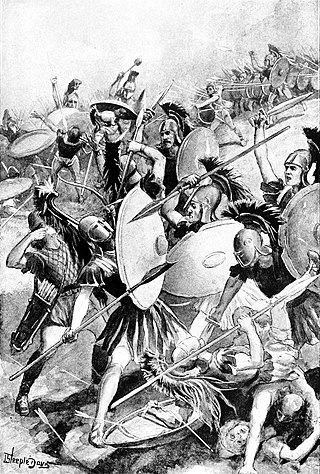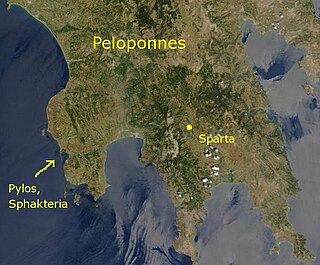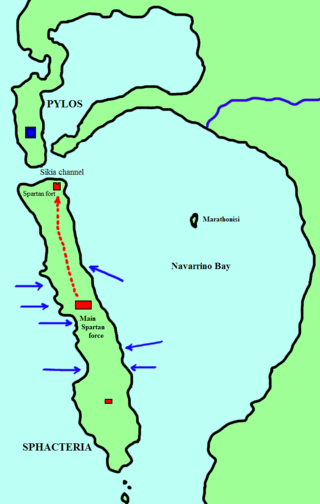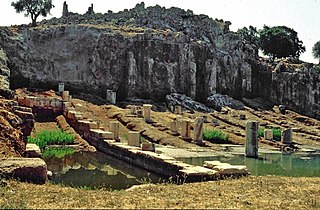Related Research Articles

The Peloponnesian War was an ancient Greek war fought between Athens and Sparta and their respective allies for the hegemony of the Greek world. The war remained undecided for a long time, until the decisive intervention of the Persian Empire in support of Sparta. Led by Lysander, the Spartan fleet, built with Persian subsidies, finally defeated Athens and started a period of Spartan hegemony over Greece.
This article concerns the period 429 BC – 420 BC.

Acarnania is a region of west-central Greece that lies along the Ionian Sea, west of Aetolia, with the Achelous River for a boundary, and north of the gulf of Calydon, which is the entrance to the Gulf of Corinth. Today it forms the western part of the regional unit of Aetolia-Acarnania. The capital and principal city in ancient times was Stratos. The north side of Acarnania of the Corinthian Gulf was considered part of the region of Epirus.

Aetolia is a mountainous region of Greece on the north coast of the Gulf of Corinth, forming the eastern part of the modern regional unit of Aetolia-Acarnania.

The Sicilian Expedition was an Athenian military expedition to Sicily, which took place from 415–413 BC during the Peloponnesian War between Athens on one side and Sparta, Syracuse and Corinth on the other. The expedition ended in a devastating defeat for the Athenian forces, severely impacting Athens.

The Battle of Naupactus was a naval battle in the Peloponnesian War. The battle, which took place a week after the Athenian victory at Rhium, set an Athenian fleet of twenty ships, commanded by Phormio, against a Peloponnesian fleet of seventy-seven ships, commanded by Cnemus.
The Battle of Olpae was a battle of the Peloponnesian War in 426 BC, between armies led by Athens and Sparta.

The naval Battle of Pylos took place in 425 BC during the Peloponnesian War at the peninsula of Pylos, on the present-day Bay of Navarino in Messenia, and was an Athenian victory over Sparta. An Athenian fleet had been driven ashore at Pylos by a storm, and, at the instigation of Demosthenes, the Athenian soldiers fortified the peninsula, and a small force was left there when the fleet departed again. The establishment of an Athenian garrison in Spartan territory frightened the Spartan leadership, and the Spartan army, which had been ravaging Attica under the command of Agis, ended their expedition and marched home, while the Spartan fleet at Corcyra sailed to Pylos.

The Battle of Sphacteria was a land battle of the Peloponnesian War, fought in 425 BC between Athens and Sparta. Following the Battle of Pylos and subsequent peace negotiations, which failed, a number of Spartans were stranded on the island of Sphacteria. An Athenian force under Cleon and Demosthenes attacked and forced them to surrender.

The Battle of Delium took place in 424 BC, during the Peloponnesian War. It was fought between the Athenians and the Boeotians, who were allies of the Spartans, and ended with the siege of Delium in the following weeks.

The Battle of Amphipolis was fought in 422 BC during the Second Peloponnesian War between Athens and Sparta. It was the culmination of events that began in 424 BC with the capture of Amphipolis by the Spartans.

Phormio, the son of Asopius, was an Athenian general and admiral before and during the Peloponnesian War. A talented naval commander, Phormio commanded at several famous Athenian victories in 428 BC, and was honoured after his death with a statue on the acropolis and a state funeral. He is considered one of Athens' many great admirals, alongside Themistocles and Cimon.

Demosthenes, son of Alcisthenes, was an Athenian general during the Peloponnesian War.
The First Peloponnesian War was fought between Sparta as the leaders of the Peloponnesian League and Sparta's other allies, most notably Thebes, and the Delian League led by Athens with support from Argos. This war consisted of a series of conflicts and minor wars, such as the Second Sacred War. There were several causes for the war including the building of the Athenian long walls, Megara's defection and the envy and concern felt by Sparta at the growth of the Athenian Empire.

Ozolian Locris or Hesperian Locris was a region in Ancient Greece, inhabited by the Ozolian Locrians a tribe of the Locrians, upon the Corinthian Gulf, bounded on the north by Doris, on the east by Phocis, and on the west by Aetolia.
The Battle of Rhium or the battle of Chalcis was a naval battle in the Peloponnesian War between an Athenian fleet commanded by Phormio and a Peloponnesian fleet composed of contingents from various states, each with its own commander. The battle came about when the Peloponnesian fleet, numbering 47 triremes, attempted to cross over to the northern shore of the Gulf of Patras to attack Acarnania in support of an offensive in northwestern Greece; Phormio's fleet attacked the Peloponnesians while they were making the crossing.
The Mytilenean revolt was an incident in the Peloponnesian War in which the city of Mytilene attempted to unify the island of Lesbos under its control and revolt from the Athenian Empire. In 428 BC, the Mytilenean government planned a rebellion in concert with Sparta, Boeotia, and certain other cities on the island, and began preparing to revolt by fortifying the city and laying in supplies for a prolonged war. These preparations were interrupted by the Athenian fleet, which had been notified of the plot, and the Mytileneans sent representatives to Athens to discuss a settlement, but simultaneously dispatched a secret embassy to Sparta to request support.

Oeniadae or Oiniadai, or Oeneiadae or Oineiadai (Οἰνειάδαι), was a town in ancient Acarnania, situated on the west bank of the Achelous River, about 10 miles from its mouth. It was one of the most important of the Acarnanian towns, being strongly fortified both by nature and by art, and commanding the whole of the south of Acarnania. It was surrounded by marshes, many of them of great extent and depth, which rendered it quite inaccessible in the winter to an invading force. Its territory appears to have extended on both sides of the Achelous, and to have consisted of the district called Paracheloitis, which was very fertile. It seems to have derived its name from the mythical Oeneus, the great Aetolian hero.
Amphilochian Argos was the chief town of ancient Amphilochia, situated at the eastern extremity of the Ambraciot Gulf, on the river Inachus. Its territory was called Argeia (Ἀργεία).

Cnemus was the Spartan fleet commander during the second and third years of the Archidamian War. During his command, Cnemus oversaw a series of operations that met with failure. As a result, the Spartans began to question Cnemus' leadership and sent several advisers to assist him in his command.
References
- Hanson, Victor Davis. A War Like No Other: How the Athenians and the Spartans Fought the Peloponnesian War (Random House, 2005) ISBN 1-4000-6095-8
- Kagan, Donald. The Archidamian War (Cornell, 1974). ISBN 0-8014-9714-0
- Thucydides. . Translated by Richard Crawley – via Wikisource.